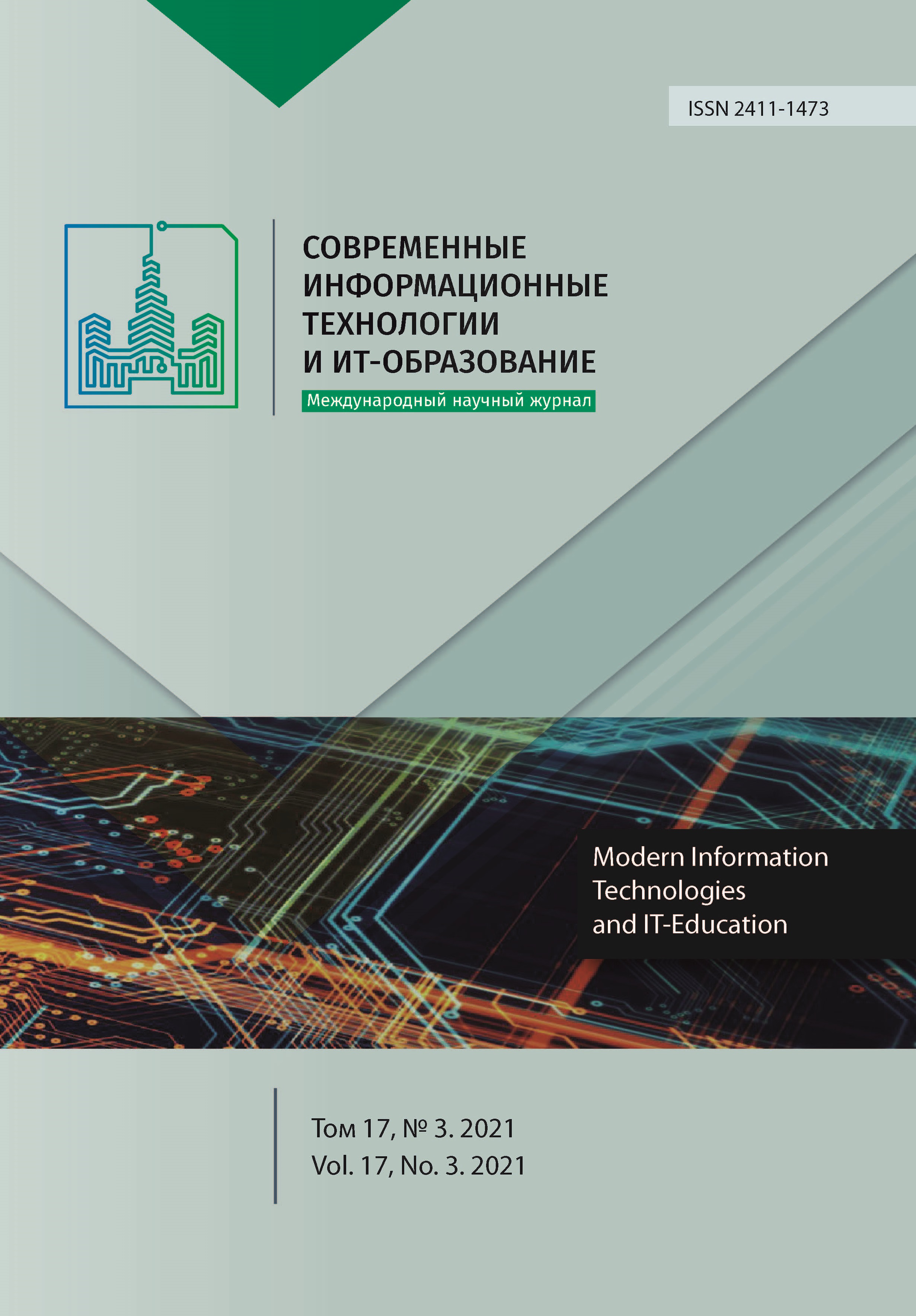Исследование прогностических возможностей многослойной нейроморфной модели, управляемой данными, на примере осциллятора Дуффинга
Аннотация
Переход к Индустрии 4.0 выдвигает на первый план области исследования, требующие качественного описания сложной системы, например, киберфизической, в виде адаптивной динамической модели, так как сами системы подвержены с течением времени изменениям под влиянием различных, иногда неизвестных, факторов. В данной работе тестируется новый метод уточнения математической модели и построение среднесрочного прогноза на основе обработки динамических измерений, полученных при взаимодействии объекта моделирования и программного обеспечения в реальном времени. В контексте необходимости сокращения времени обработки и сложности модели мы используем наши многослойные модели на основе сеточных методов, применяемых к интервалу времени переменной длины. Разработанные нами методы являются альтернативным способом построения приближённых функциональных решений дифференциальных уравнений. В данной работе этот подход используется для решения уравнения Дуффинга с переменным параметром. В качестве базовых методов используются универсальные итерационные формулы для дифференциальных уравнений первого порядка в виде различных модификаций метода Эйлера и метод Штёрмера для уравнений второго порядка. В статье приведены результаты вычислений времени выполнения итераций и их сравнительный анализ, а также предварительная оценка наличия значимых отличий применяемых схем при помощи критерия Фридмана для выборки с неизменными параметрами и попарное сравнение по критерию Уилкоксона для определения характера различия величин. Вычисления проводились с помощью пакета Wolfram Mathematica, а анализировались с помощью встроенных функций пакета Excel. Полученные данные помогают оптимизировать использование схем в практических целях, таким образом, проведенное нами сравнительное исследование свойств разных моделей позволяет выбрать наиболее подходящую модель в зависимости от конкретной решаемой задачи. На основе этих данных в будущем возможна разработка системы, автоматически выбирающей наиболее приемлемый (из представленных) метод решения задачи, определяемой входными данными.
Литература
2. Rai R., Sahu C.K. Driven by Data or Derived through Physics? A Review of Hybrid Physics Guided Machine Learning Techniques with Cyber-Physical System (CPS) Focus. IEEE Access. 2020; 8:71050-71073. (In Eng.) DOI: https://doi.org/10.1109/ACCESS.2020.2987324
3. Frank M., Drikakis D., Charissis V. Machine-Learning Methods for Computational Science and Engineering. Computation. 2020; 8(1):15. (In Eng.) DOI: https://doi.org/10.3390/computation8010015
4. Lazovskaya T., Malykhina G., Tarkhov D. Physics-based neural network methods for solving parameterized singular perturbation problem. Computation. 2021; 9(9):97. (In Eng.) DOI: https://doi.org/10.3390/computation9090097
5. Boyarsky S., Lazovskaya T., Tarkhov D. Investigation of the Predictive Capabilities of a Data-Driven Multilayer Model by the Example of the Duffing Oscillator. Proceedings of the 2020 International Multi-Conference on Industrial Engineering and Modern Technologies (FarEastCon). IEEE Press, Vladivostok, Russia; 2020. p. 1-5. (In Eng.) DOI: https://doi.org/10.1109/FarEastCon50210.2020.9271195
6. Kovacic I., Brennan M.J. The Duffing Equation: Nonlinear Oscillators and their Behaviour. John Wiley & Sons, Ltd.; 2011. 392 p. (In Eng.) DOI: https://doi.org/10.1002/9780470977859
7. Lagaris I.E., Likas A., Fotiadis D.I. Artificial neural networks for solving ordinary and partial differential equations. IEEE Transactions on Neural Networks. 1998; 9(5):987-1000. (In Eng.) DOI: https://doi.org/10.1109/72.712178
8. Kumar M., Yadav N. Multilayer perceptrons and radial basis function neural network methods for the solution of differential equations: A survey. Computers and Mathematics with Applications. 2011; 62(10):3796-3811. (In Eng.) DOI: https://doi.org/10.1016/j.camwa.2011.09.028
9. Mai-Duy N. Solving high order ordinary differential equations with radial basis function networks. International Journal for Numerical Methods in Engineering. 2005; 6(92):824-852. (In Eng.) DOI: https://doi.org/10.1002/nme.1220
10. Lazovskaya T.V., Tarkhov D.A., Vasilyev A.N. Parametric Neural Network Modeling in Engineering. Recent Patents on Engineering. 2017; 11(1):10-15. (In Eng.) DOI: https://doi.org/10.2174/1872212111666161207155157
11. Lazovskaya T.V., Tarkhov D.A. Fresh approaches to the construction of parameterized neural network solutions of a stiff differential equation. St. Petersburg Polytechnical University Journal: Physics and Mathematics. 2015; 1(2):192-198. (In Eng.) DOI: https://doi.org/10.1016/j.spjpm.2015.07.005
12. Budkina E.M., Kuznetsov E.B., Lazovskaya T.V., Leonov S.S., Tarkhov D.A., Vasilyev A.N. Neural Network Technique in Boundary Value Problems for Ordinary Differential Equations. In: Ed. by L. Cheng, Q. Liu, A. Ronzhin. Advances in Neural Networks – ISNN 2016. ISNN 2016. Lecture Notes in Computer Science. 2016; 9719:277-283. Springer, Cham. (In Eng.) DOI: https://doi.org/10.1007/978-3-319-40663-3_32
13. Gorbachenko V.I., Lazovskaya T.V., Tarkhov D.A., Vasilyev A.N., Zhukov M.V. Neural Network Technique in Some Inverse Problems of Mathematical Physics. In: Ed. by L. Cheng, Q. Liu, A. Ronzhin. Advances in Neural Networks – ISNN 2016. ISNN 2016. Lecture Notes in Computer Science. 2016; 9719:310-316. Springer, Cham. (In Eng.) DOI: https://doi.org/10.1007/978-3-319-40663-3_36
14. Shemyakina T.A., Tarkhov D.A., Vasilyev A.N. Neural Network Technique for Processes Modeling in Porous Catalyst and Chemical Reactor. In: Ed. by L. Cheng, Q. Liu, A. Ronzhin. Advances in Neural Networks – ISNN 2016. ISNN 2016. Lecture Notes in Computer Science. 2016; 9719:547-554. Springer, Cham. (In Eng.) DOI: https://doi.org/10.1007/978-3-319-40663-3_63
15. Vasilyev A.N., Kolbin I.S., Reviznikov D.L. Meshfree Computational Algorithms Based on Normalized Radial Basis Functions. In: Ed. by L. Cheng, Q. Liu, A. Ronzhin. Advances in Neural Networks – ISNN 2016. ISNN 2016. Lecture Notes in Computer Science. 2016; 9719:583-591. Springer, Cham. (In Eng.) DOI: https://doi.org/10.1007/978-3-319-40663-3_67
16. Kuznetsov E.B., Leonov S.S., Tarkhov D.A., Vasilyev A.N. Multilayer Method for Solving a Problem of Metals Rupture under Creep Conditions. Thermal Science. 2019; 23(2):575-582. (In Eng.) DOI: https://doi.org/10.2298/TSCI19S2575K
17. Tarkhov D.A., Vasilyev A.N. Semi-Empirical Neural Network Modeling and Digital Twins Development. Academic Press, Elsevier; 2019. 288 p. (In Eng.) DOI: https://doi.org/10.1016/C2017-0-02027-X
18. Zhang M., Drikakis D., Li L., Yan X. Machine-Learning Prediction of Underwater Shock Loading on Structures. Computation. 2019; 7(4):58. (In Eng.) DOI: https://doi.org/10.3390/computation7040058
19. Egorchev M.V., Tiumentsev Y.V. Semi-Empirical Continuous Time Neural Network Based Models for Controllable Dynamical Systems. Optical Memory and Neural Networks. 2019; 28(3);192-203. (In Eng.) DOI: https://doi.org/10.3103/S1060992X1903010X
20. Raissi M., Perdikaris P., Karniadakis G. Physics-informed neural networks: A deep learning framework for solving forward and inverse problems involving nonlinear partial differential equations. Journal of Computational Physics. 2019; 378:686-707. (In Eng.) DOI: https://doi.org/10.1016/j.jcp.2018.10.045
21. Han J., Jentzen A., Weinan E. Solving high-dimensional partial differential equations using deep learning. Proceedings of the National Academy of Sciences. 2018; 115(34):8505-8510. (In Eng.) DOI: https://doi.org/10.1073/pnas.1718942115
22. Sirignano J., Spiliopoulos K. DGM: A deep learning algorithm for solving partial differential equations. Journal of Computational Physics. 2018; 375:1339-1364. (In Eng.) DOI: https://doi.org/10.1016/j.jcp.2018.08.029
23. Linde Y., Buzo A., Gray R. An Algorithm for Vector Quantizer Design. IEEE Transactions on Communications. 1980; 28(1):84-95. (In Eng.) DOI: https://doi.org/10.1109/TCOM.1980.1094577
24. Pang G., D'Elia M., Parks M., Karniadakis G.E. nPINNs: Nonlocal physics-informed neural networks for a parametrized nonlocal universal Laplacian operator. Algorithms and applications. Journal of Computational Physics. 2020; 422:109760. (In Eng.) DOI: https://doi.org/10.1016/j.jcp.2020.109760
25. Yang X., Li Z., Dahhou B. Parameter and State Estimation for Uncertain Nonlinear Systems by Adaptive Observer Based on Differential Evolution Algorithm. Applied Science. 2020; 10(17):5857. (In Eng.) DOI: https://doi.org/10.3390/app10175857

Это произведение доступно по лицензии Creative Commons «Attribution» («Атрибуция») 4.0 Всемирная.
Редакционная политика журнала основывается на традиционных этических принципах российской научной периодики и строится с учетом этических норм работы редакторов и издателей, закрепленных в Кодексе поведения и руководящих принципах наилучшей практики для редактора журнала (Code of Conduct and Best Practice Guidelines for Journal Editors) и Кодексе поведения для издателя журнала (Code of Conduct for Journal Publishers), разработанных Комитетом по публикационной этике - Committee on Publication Ethics (COPE). В процессе издательской деятельности редколлегия журнала руководствуется международными правилами охраны авторского права, нормами действующего законодательства РФ, международными издательскими стандартами и обязательной ссылке на первоисточник.
Журнал позволяет авторам сохранять авторское право без ограничений. Журнал позволяет авторам сохранить права на публикацию без ограничений.
Издательская политика в области авторского права и архивирования определяются «зеленым цветом» в базе данных SHERPA/RoMEO.
Все статьи распространяются на условиях лицензии Creative Commons «Attribution» («Атрибуция») 4.0 Всемирная, которая позволяет другим использовать, распространять, дополнять эту работу с обязательной ссылкой на оригинальную работу и публикацию в этом журналe.













